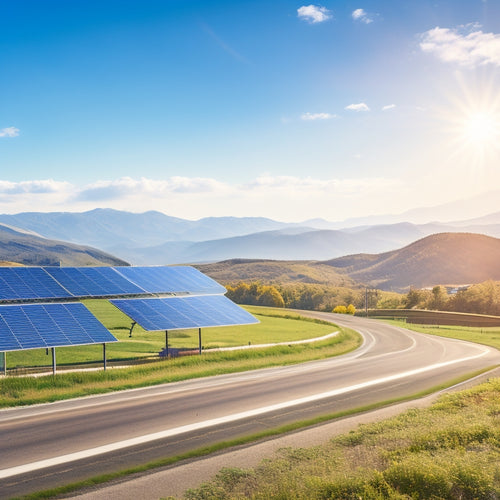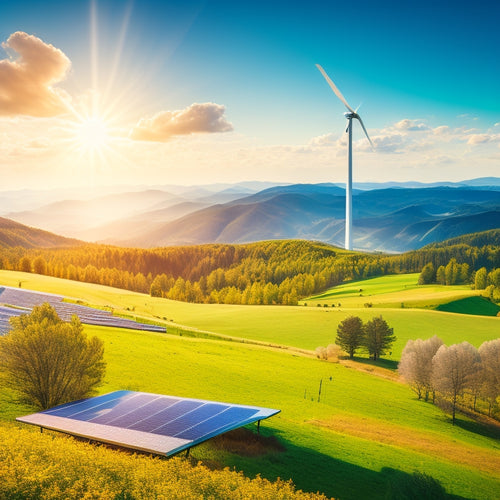
What DIY Installation Costs Homeowners Least
Share
When it comes to DIY solar panel installation, you'll want to minimize costs without sacrificing efficiency. To do so, research high-quality solar kits with UL and IEC certification to reduce costs via federal incentives. Measure your roof's dimensions to determine solar panel capacity and placement, and evaluate its structural integrity before installation. Comparing costs and supplier prices for ideal deals is also essential. By streamlining the installation process, you'll minimize labor costs and time spent. Now, learn how to make the most of your investment by maximizing energy savings and identifying potential risks and areas for improvement in your DIY solar panel project.
Overview
- High-quality solar kits with UL and IEC certification can reduce costs via federal incentives, minimizing DIY installation expenses.
- Researching and comparing costs of solar panels, mounting hardware, inverters, and tools is crucial for budgeting effectively and saving money.
- Choosing the right equipment, such as budget-friendly thin-film solar panels, can lower upfront costs for DIY installers.
- Streamlining the installation process and utilizing the right tools can minimize labor costs and time spent, reducing overall DIY installation costs.
- Federal government's 26% tax credit for solar installations can significantly lower DIY installation costs for homeowners.
Understanding Solar Panel Costs
When considering a DIY solar panel installation, understanding the costs involved is essential to determining whether this renewable energy solution fits your budget.
You'll need to factor in the cost of the solar panels themselves, as well as additional expenses like mounting hardware, inverters, and installation tools. High-quality solar kits that meet UL and IEC certification standards can provide an extensive solution, often with federal incentives that can greatly reduce installation costs.
Fortunately, there are solar incentives and financing options available to help offset these costs. For example, the federal government offers a 26% tax credit for solar installations, and many states and utilities offer additional rebates and incentives.
You can also investigate financing options like solar loans or power purchase agreements to make your DIY installation more affordable.
Assessing Roof Size and Condition
Before you start planning your DIY solar panel installation, take a closer look at your roof's size and condition.
You'll need to measure your roof to determine how many solar panels you can fit and where they'll go. Take precise roof measurements to identify the most suitable areas for installation.
Consider the ideal system layout based on roof size and orientation to guarantee peak efficiency and meets energy needs. Additionally, evaluate the roof's structural integrity against wind and snow loads to guarantee a secure installation.
Next, conduct a damage evaluation to identify any potential issues that could affect your solar panel installation.
Check for signs of wear, cracks, or missing shingles. Consider repairing or replacing damaged sections before installing your solar panels. This will guarantee a safe and secure installation.
Choosing the Right Equipment
With your roof size and condition assessed, you're ready to select the right equipment for your DIY solar panel installation.
You'll need to choose between different equipment types, including monocrystalline, polycrystalline, and thin-film solar panels. Each type has its own advantages and disadvantages, with varying efficiency rates and prices.
Monocrystalline panels are the most efficient but also the priciest, while thin-film panels are more budget-friendly but less efficient.
Consider the importance of high-efficiency panels and durable mounting systems for successful DIY installations.
Compare costs and efficiency rates to determine which type best suits your needs and budget. Additionally, consider the inverter type, mounting system, and monitoring equipment.
Research and compare prices from different suppliers to get the best deals.
Permits and Local Regulations
Your DIY solar panel installation checklist isn't complete without addressing permits and local regulations.
You'll need to verify your installation meets local building codes and complies with regulations. This involves submitting permit applications, which can vary depending on your location.
Research the specific requirements for your area and factor in the time and cost of obtaining necessary permits.
Failure to comply can result in fines, removal of the system, or even electrical disconnection.
Don't risk it – take the time to understand and comply with local regulations.
This may add some upfront cost, but it's vital for a safe and legal installation.
Installation Time and Labor
This essential aspect of DIY solar panel installation can quickly add up: the time and labor required to get the job done.
As you take on the project, you'll need to take into account the hours you'll spend planning, preparing, and executing the installation. Your installation efficiency will directly impact your labor savings.
The more efficient you are, the less time and effort you'll waste. To minimize labor costs, focus on streamlining your process, using the right tools, and breaking down complex tasks into manageable chunks.
Safety Precautions and Risks
Electrical shock, falls, and equipment damage are just a few of the hazards that can arise when tackling a DIY solar panel installation. You must take electrical hazards seriously, ensuring you disconnect the main power supply before starting work.
Fall risks are also a major concern, so always maintain three points of contact with the roof or ladder, and consider enlisting a spotter for added safety.
Tool safety is essential, so keep your tools in good condition and store them properly when not in use.
Weather considerations are also important, as strong winds or lightning storms can make it dangerous to work on your roof.
Wear protective gear, including gloves, safety glasses, and a safety harness, and have emergency procedures in place in case of an accident.
Maximizing Energy Savings
Optimizing your solar panel system's performance is essential to maximize energy savings.
You'll want to confirm your system is running at its best to get the most out of your investment. To do this, consider energy efficient upgrades like upgrading to a smart inverter or adding a monitoring system.
Additionally, don't forget about your home's insulation - a well-insulated home can help reduce energy consumption. Check for gaps and cracks in your walls, floors, and ceilings, and seal them to prevent heat from escaping.
Frequently Asked Questions
Can I Install Solar Panels on a Metal or Tile Roof?
You can install solar panels on a metal or tile roof, but consider metal roof's potential for rusty or damaged surfaces, and tile roof's advantages like easier installation and fewer structural concerns.
Will DIY Solar Installation Void My Roof Warranty?
You're taking a bold step by considering DIY solar installation, but hold on - will it void your roof warranty? Unfortunately, yes, it might, depending on your roof warranty implications and adherence to DIY solar guidelines.
How Do I Maintain and Clean My Solar Panels?
You'll maximize your solar panel's energy output by performing regular solar panel maintenance, using gentle cleaning techniques like soft brushes and distilled water to remove debris, ensuring peak performance and freedom from energy dependence.
Can I Add More Solar Panels to My Existing System?
You can expand your solar panel setup to enhance energy production, but first, assess your existing system's capacity and compatibility; then, add new panels that match your current system's voltage and wattage to guarantee a seamless solar panel expansion.
Do Solar Panels Work During a Power Outage?
You won't have backup power during an outage with a standard solar panel setup, as they're grid-tied for safety and efficiency. However, you can invest in a battery backup system to guarantee continuous power when the grid goes down.
Ready to Buy
As you near the finish line of your DIY solar panel installation, imagine flipping the switch and utilizing the power of the sun to energize your home. You've invested time and effort to minimize costs, from evaluating your roof to choosing the right equipment. Now, bask in the savings and sustainability you've created. But ask yourself: what's the true cost of waiting to tap into this renewable energy source?
Related Posts
-

Is Switching to Green Energy Solutions Easy
Switching to green energy solutions isn't just easy; it's also beneficial. You can greatly cut utility costs and enjo...
-

Renewable Energy Solutions to Reduce Your Carbon Footprint
To reduce your carbon footprint, adopting renewable energy solutions is key. Using solar panels or wind turbines can ...
-

Why Outdoor Solar Lighting Systems Are Sustainable
Outdoor solar lighting systems are sustainable because they utilize renewable energy, drastically reducing your carbo...


